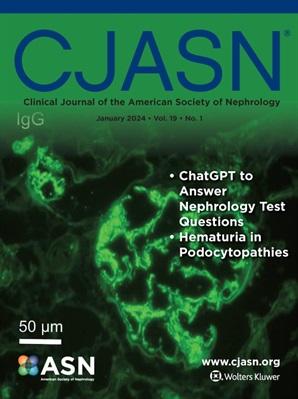Dialysis Dependence in Standard Versus Accelerated Initiation of Kidney Replacement Therapy in Acute Kidney Injury: A Post-Hoc Analysis
IF 8.5
1区 医学
Q1 UROLOGY & NEPHROLOGY
Clinical Journal of the American Society of Nephrology
Pub Date : 2025-03-11
DOI:10.2215/cjn.0000000672
引用次数: 0
Abstract
ompared to a standard strategy. However, it is unclear whether this difference exists among participants who likely would have been treated with KRT in usual practice. Methods: Secondary analysis of the STARRT-AKI randomized controlled trial, analyzing participants who received more than the median number of days of KRT, which served as a proxy for high probability of requiring KRT under usual practice. Two sensitivity analyses redefined the cohort as 1) those with ≥24 hours of oliguria who received KRT and 2) those who received any RT. Using the same statistical approach Kas the original trial, we calculated unadjusted relative risks with 95% confidence intervals (CI) for the exposure of randomized KRT initiation strategy (accelerated vs. standard) on the outcome of KRT dependence at 90 days among survivors. Results: Among the 1,184 participants who received ≥six days of KRT (670 and 514 in the accelerated and standard arms, respectively), baseline characteristics remained balanced between treatment arms. The relative risk of KRT dependence at 90 days was attenuated and non-significant: 1.21 (95% CI 0.84-1.78), compared to 1.74 (95% CI 1.24-2.43) in the overall trial. Results were similar in sensitivity analyses. Conclusions: Among patients who likely would have been treated with KRT in usual practice, there was no significant difference in 90-day KRT dependence among survivors between those randomized to the accelerated and standard KRT initiation strategies. These results suggest that the harm of long-term KRT dependence may be largely due to KRT initiation (vs never initiation) rather than earlier initiation. Copyright © 2025 by the American Society of Nephrology...急性肾损伤患者标准肾替代治疗与加速启动肾替代治疗的透析依赖性:事后分析
与标准策略相比。然而,尚不清楚在通常可能接受KRT治疗的参与者中是否存在这种差异。方法:对STARRT-AKI随机对照试验进行二次分析,分析接受KRT治疗天数超过中位数的参与者,这是通常情况下需要KRT治疗的高概率的代表。两项敏感性分析将队列重新定义为1)接受KRT的少尿≥24小时者和2)接受任何rt的人。使用与原始试验相同的统计方法,我们计算了随机KRT起始策略(加速vs标准)暴露对幸存者90天KRT依赖结果的未调整相对风险(95%置信区间(CI))。结果:在接受KRT≥6天的1184名参与者中(分别为加速组和标准组670名和514名),基线特征在治疗组之间保持平衡。90天KRT依赖的相对风险减弱且不显著:1.21 (95% CI 0.84-1.78),而整个试验的相对风险为1.74 (95% CI 1.24-2.43)。敏感性分析结果相似。结论:在通常可能接受KRT治疗的患者中,随机分配到加速和标准KRT起始策略的幸存者中90天KRT依赖性没有显着差异。这些结果表明,长期KRT依赖的危害可能主要是由于KRT启动(与从未启动)而不是早期启动。版权所有©2025 by美国肾脏学会…
本文章由计算机程序翻译,如有差异,请以英文原文为准。
求助全文
约1分钟内获得全文
求助全文
来源期刊
CiteScore
12.20
自引率
3.10%
发文量
514
审稿时长
3-6 weeks
期刊介绍:
The Clinical Journal of the American Society of Nephrology strives to establish itself as the foremost authority in communicating and influencing advances in clinical nephrology by (1) swiftly and effectively disseminating pivotal developments in clinical and translational research in nephrology, encompassing innovations in research methods and care delivery; (2) providing context for these advances in relation to future research directions and patient care; and (3) becoming a key voice on issues with potential implications for the clinical practice of nephrology, particularly within the United States. Original manuscript topics cover a range of areas, including Acid/Base and Electrolyte Disorders, Acute Kidney Injury and ICU Nephrology, Chronic Kidney Disease, Clinical Nephrology, Cystic Kidney Disease, Diabetes and the Kidney, Genetics, Geriatric and Palliative Nephrology, Glomerular and Tubulointerstitial Diseases, Hypertension, Maintenance Dialysis, Mineral Metabolism, Nephrolithiasis, and Transplantation.

 求助内容:
求助内容: 应助结果提醒方式:
应助结果提醒方式:


